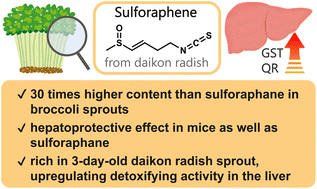Comparative analysis of isothiocyanates in eight cruciferous vegetables and evaluation of the hepatoprotective effects of 4-(methylsulfinyl)-3-butenyl isothiocyanate (sulforaphene) from daikon radish (Raphanus sativus L.) sprouts
Abstract
The contributions of cruciferous vegetables to human health are widely recognised, particularly at the molecular level, where their isothiocyanates play a significant role. However, compared to the well-studied isothiocyanate 4-(methylsulfinyl)butyl isothiocyanate (sulforaphane) produced from broccoli sprouts, less is known about the pharmacological effects of other isothiocyanates and the stage of vegetables preferable to obtain their benefits. We analysed the quantity and quality of isothiocyanates produced in both the sprouts and mature stages of eight cruciferous vegetables using gas chromatography-mass spectrometry (GC-MS). Additionally, we investigated the hepatoprotective effects of isothiocyanates in a mouse model of acute hepatitis induced by carbon tetrachloride (CCl4). Furthermore, we explored the detoxification enzyme-inducing activities of crude sprout extracts in normal rats. Among the eight cruciferous vegetables, daikon radish (Raphanus sativus L.) sprouts produced the highest amount of isothiocyanates, with 4-(methylsulfinyl)-3-butenyl isothiocyanate (sulforaphene) being the dominant compound. The amount of sulforaphene in daikon radish sprouts was approximately 30 times that of sulforaphane in broccoli sprouts. Sulforaphene demonstrated hepatoprotective effects similar to sulforaphane in ameliorating CCl4-induced hepatic injury in mice. A crude extract of 3-day-old daikon radish sprouts upregulated the detoxifying enzyme glutathione S-transferase (GST) in the liver, whereas the crude extract of broccoli sprouts showed limited upregulation. This study highlights that daikon radish sprouts and sulforaphene have the potential to serve as functional food materials with hepatoprotective effects. Furthermore, daikon radish sprouts may exhibit more potent hepatoprotective effects compared to broccoli sprouts.



 Please wait while we load your content...
Please wait while we load your content...